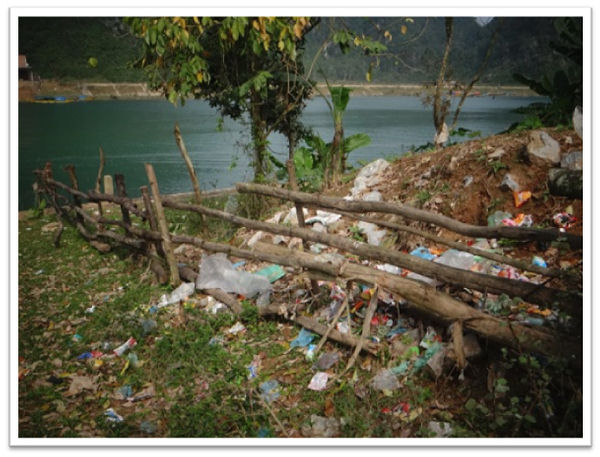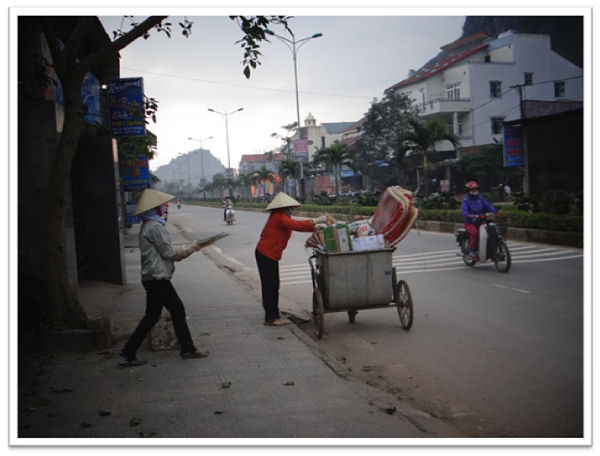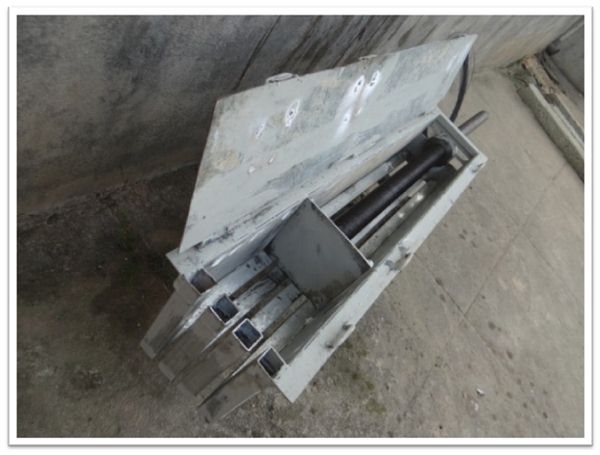by Patrick Mills, ECOCLUB.com Correspondent
 Phong Nha-Ke Bang National Park recognized as a UNESCO World Heritage Site in 2003 for its incredible high-rising geological features, harbours hundreds of fascinating cave systems including Hang Son Doong, the world's largest, and Hang Phong Nha, one of the longest underground rivers. As such, Phong Nha village (AKA Son Trach Commune), located in a region often considered one of the poorest in Vietnam, has boomed in the last 20 years, catapulting an impoverished people into modern Vietnam and turning the village into a popular destination. Alongside this growth there has been a steady increase in solid waste volume. Inefficient local waste management initiatives, the rampant consumption by both international and domestic tourists in purchasing take-away (and the food packaging that comes with it), crisp bags, cigarette packets etc. combined with tourists' disregard for littering, have left visible marks on the local environment. This report will look at some of the causes for increased solid waste volumes in Phong Nha and will focus on a current project put in in place by local tourism ventures and its future potential in curbing solid waste volumes locally, nationally and globally.
Phong Nha-Ke Bang National Park recognized as a UNESCO World Heritage Site in 2003 for its incredible high-rising geological features, harbours hundreds of fascinating cave systems including Hang Son Doong, the world's largest, and Hang Phong Nha, one of the longest underground rivers. As such, Phong Nha village (AKA Son Trach Commune), located in a region often considered one of the poorest in Vietnam, has boomed in the last 20 years, catapulting an impoverished people into modern Vietnam and turning the village into a popular destination. Alongside this growth there has been a steady increase in solid waste volume. Inefficient local waste management initiatives, the rampant consumption by both international and domestic tourists in purchasing take-away (and the food packaging that comes with it), crisp bags, cigarette packets etc. combined with tourists' disregard for littering, have left visible marks on the local environment. This report will look at some of the causes for increased solid waste volumes in Phong Nha and will focus on a current project put in in place by local tourism ventures and its future potential in curbing solid waste volumes locally, nationally and globally.
Tourism in Phong Nha has been ongoing for almost 20 years yet it was only recently that it really started to pick up. From 2011 to 2013 total visitor numbers rose 35% from 438,000 to 662,000 according to a study conducted by Quang Binh University. Domestic Tourism represented 97.4% of the total. A fast-developing country and growing expendable incomes have led to a rise in domestic tourism in popular Vietnamese destinations. Domestic tourists have a visible contribution to solid waste volumes and have a lack of environmental awareness about the effects of plastic, styrofoam, bottles and snack packets. This is evident in the trail of litter left behind by the busloads of domestic tourists who swarm to visit the Phong Nha Cave.
 There is little information on Phong Nha western tourism trends but from observation, it seems that most western visitors to Phong Nha are backpackers. Arguably more aware of the waste's environmental impact, backpackers who come to see the Phong Nha natural landscape seem less likely to litter. Having said this they do still contribute to waste volumes. The consumerist culture brought on by international tourists in the form of street food, snacks and drinks certainly adds to the solid waste volumes.
There is little information on Phong Nha western tourism trends but from observation, it seems that most western visitors to Phong Nha are backpackers. Arguably more aware of the waste's environmental impact, backpackers who come to see the Phong Nha natural landscape seem less likely to litter. Having said this they do still contribute to waste volumes. The consumerist culture brought on by international tourists in the form of street food, snacks and drinks certainly adds to the solid waste volumes.
As aforementioned, tourism is relatively new in the Quang Binh region, as is the use of plastic and styrofoam. Recycling initiatives do exist and local women push carts down the streets sorting cans and plastic bottles which in turn are sold to larger recycling companies within Quang Binh province. Yet polyethylene (thin plastics such as shopping bags), as well as styrofoam, have little value in recycling and the same applies to snack packets and fertilizer bags. As such, rubbish is left along the banks of the Son river or taken to the local dump where it is burned. It is also not uncommon for families living by the riverbanks to throw their bags in the Son river. As an effect, waste is washed out to sea or into the National Park where plastic bags have even been found in the river caves. It seems that a lack of knowledge on the non-biodegradability of synthetic waste as well as lack of clear initiatives in solid waste management means little is done to tackle the issue.
In 2011, Son Trach had a population of 10,653 inhabitants (source: www.quangbinh.gov.vn). Average daily tourist numbers in the same year were a total of 438,007 (source: Quang Binh University) representing more than 40 times the local population number. Currently there is little literature on the volume of solid waste in Phong Nha and so it is difficult to show any correlation between tourist numbers and said volumes. However, by taking these tourist figures into account one can understand that the sheer number of daily tourist influx compared to local inhabitant numbers must contribute to local solid waste.
 Having said this, although tourism plays its part in waste, it can also be a part of the solution: a group of expats in Phong Nha are currently working together on a way around the burning and dumping of certain types of non-biodegradable waste. The idea originated from Texas-based inventor and humanist Harvey Lacey and his Ubuntu Blox Project (web: ubuntublox.com). Lacey is an entrepreneur in waste management alternatives, his first project was based in Haiti and the issues in waste, lack of employment and affordable housing. The Ubuntu Blox Project has tackled these with one solid idea; taking styrofoam and thin plastic bags and compressing these into blocks which in turn can be used in construction. They have proven to have great insulating qualities as well as being wind and earthquake resistant. The blocks are compressed through a manual machine, again designed by Harvey Lacey, whose designs are freely available for those who are interested on his website.
Having said this, although tourism plays its part in waste, it can also be a part of the solution: a group of expats in Phong Nha are currently working together on a way around the burning and dumping of certain types of non-biodegradable waste. The idea originated from Texas-based inventor and humanist Harvey Lacey and his Ubuntu Blox Project (web: ubuntublox.com). Lacey is an entrepreneur in waste management alternatives, his first project was based in Haiti and the issues in waste, lack of employment and affordable housing. The Ubuntu Blox Project has tackled these with one solid idea; taking styrofoam and thin plastic bags and compressing these into blocks which in turn can be used in construction. They have proven to have great insulating qualities as well as being wind and earthquake resistant. The blocks are compressed through a manual machine, again designed by Harvey Lacey, whose designs are freely available for those who are interested on his website.
 Local expat hotel owners have decided to build a manual press machine and begin tackling the Phong Nha waste issue head on. The ultimate goal is for these blocks to be used in construction, replacing cement blocks where possible. Expat tourism ventures are looking to use these first hand in constructions, acting as prime examples to surrounding communities on the potential alternative uses for solid waste. Ideally the local government could play a role in funding for the Ubuntu Blox, however, given political constraints often apparent in the global south, seeking government attention or aid can take time and money. As such, the first press was funded by local expats. However, in the future, tourists themselves can also play a part in funding such projects through ways such as crowdfunding. By raising tourist awareness on the issues of tourism and solid waste as well as on the possible solutions, tourists themselves may contribute to the future production of these manual presses in the form of donations.
Local expat hotel owners have decided to build a manual press machine and begin tackling the Phong Nha waste issue head on. The ultimate goal is for these blocks to be used in construction, replacing cement blocks where possible. Expat tourism ventures are looking to use these first hand in constructions, acting as prime examples to surrounding communities on the potential alternative uses for solid waste. Ideally the local government could play a role in funding for the Ubuntu Blox, however, given political constraints often apparent in the global south, seeking government attention or aid can take time and money. As such, the first press was funded by local expats. However, in the future, tourists themselves can also play a part in funding such projects through ways such as crowdfunding. By raising tourist awareness on the issues of tourism and solid waste as well as on the possible solutions, tourists themselves may contribute to the future production of these manual presses in the form of donations.
 The Ubuntu Blox Project overall is still at a very young stage and at this point it is difficult to grasp exactly what share of the solid waste volume it will absorb. The scale of the project mainly depends on the location, the volume and type of waste as well as who chooses to take the project on. In the context of Phong Nha, each building block is currently using about 3 feet of waste, more or less equivalent to 3 full plastic carrier bags. Initiatives like this may not present a major solution for solid waste management, yet, when solid waste management is inefficient for particular forms of waste, and is leading to burning or dumping; relatively cheap and inexpensive solutions are welcome.
The Ubuntu Blox Project overall is still at a very young stage and at this point it is difficult to grasp exactly what share of the solid waste volume it will absorb. The scale of the project mainly depends on the location, the volume and type of waste as well as who chooses to take the project on. In the context of Phong Nha, each building block is currently using about 3 feet of waste, more or less equivalent to 3 full plastic carrier bags. Initiatives like this may not present a major solution for solid waste management, yet, when solid waste management is inefficient for particular forms of waste, and is leading to burning or dumping; relatively cheap and inexpensive solutions are welcome.
Ha Long Bay, one of Vietnam's most popular destinations, is known for being hugely polluted and littered, as are plenty of beaches along the Vietnamese coast. The same is apparent in many other popular tourism destinations such as Goa, India, and Bali, Indonesia. The manual press machine limits itself to building blocks, however reusing non-recycled waste in tourism can and has been initiated in various ways across the world. In Santiago, Chile, local women were taught by the local government how to make decorative souvenirs from waste (see http://santiago-city.com/village-women-undergo-training-on-recyclable-materials/). This not only helped tackle Santiago's waste volumes but also provided another source of income for the women. These projects can serve as examples to other destinations that tourism stakeholders can take up such initiatives and in doing so are improving their own image, cleaning the environment and aiding the local communities, whilst all the while ensuring a better overall experience for visitors.
Patrick Esteves Mills has a bachelor’s degree in Tourism and Geography. Primarily in Asia, he has engaged in sustainable, adventure-based and community-based tourism development. Patrick's focus is in establishing a career in international responsible tourism consulting..
